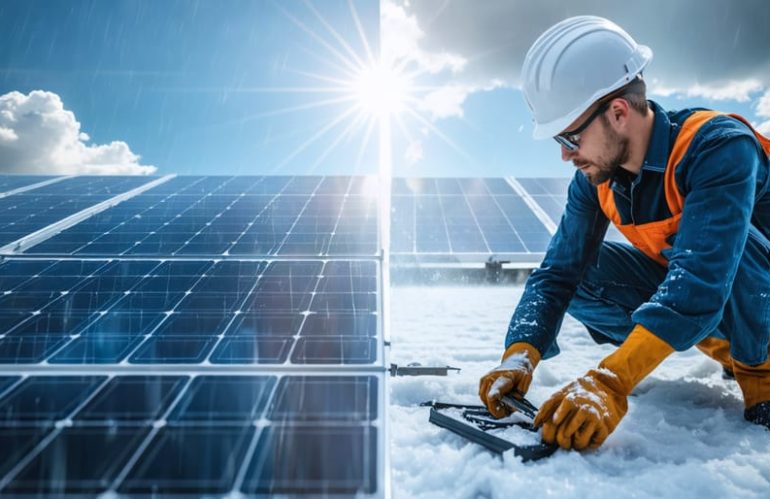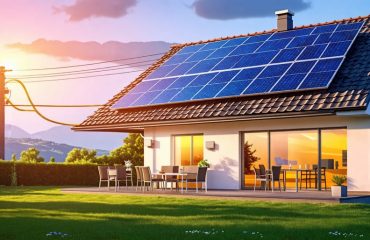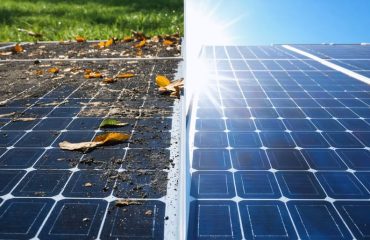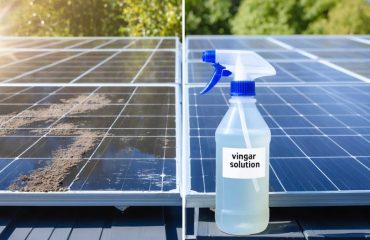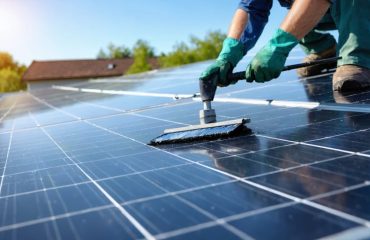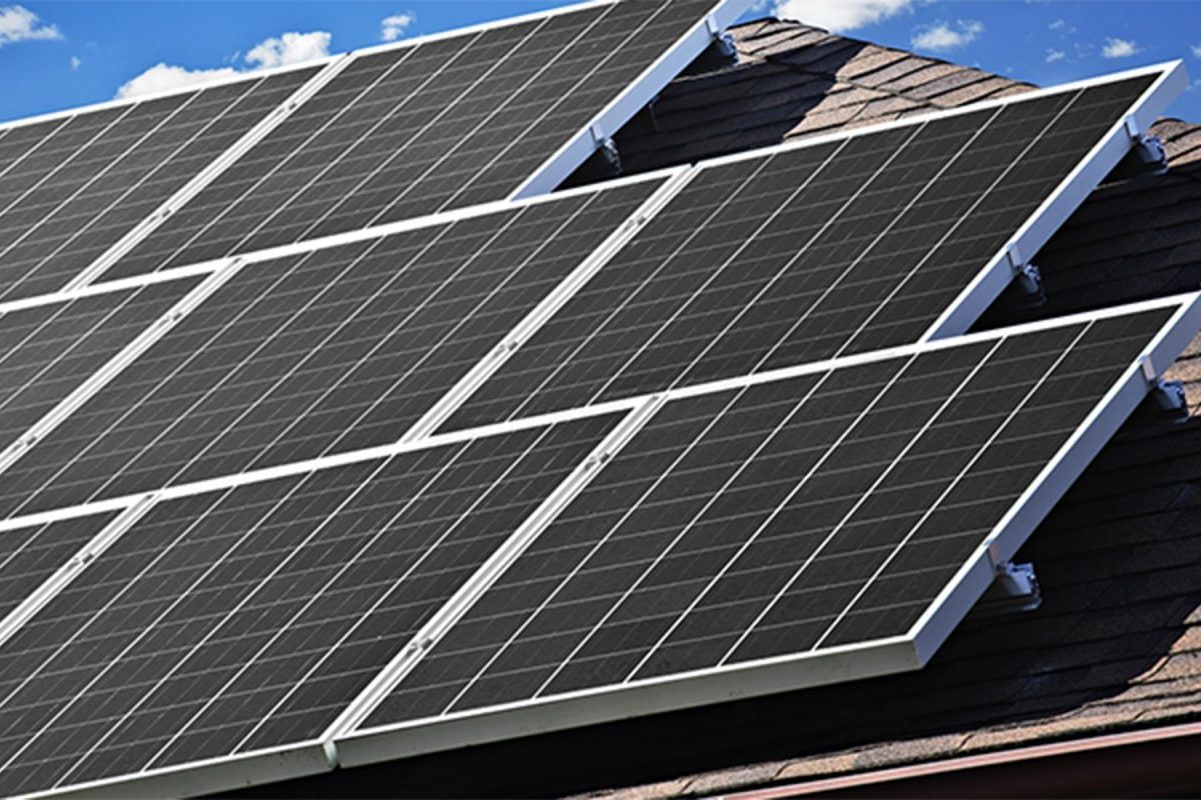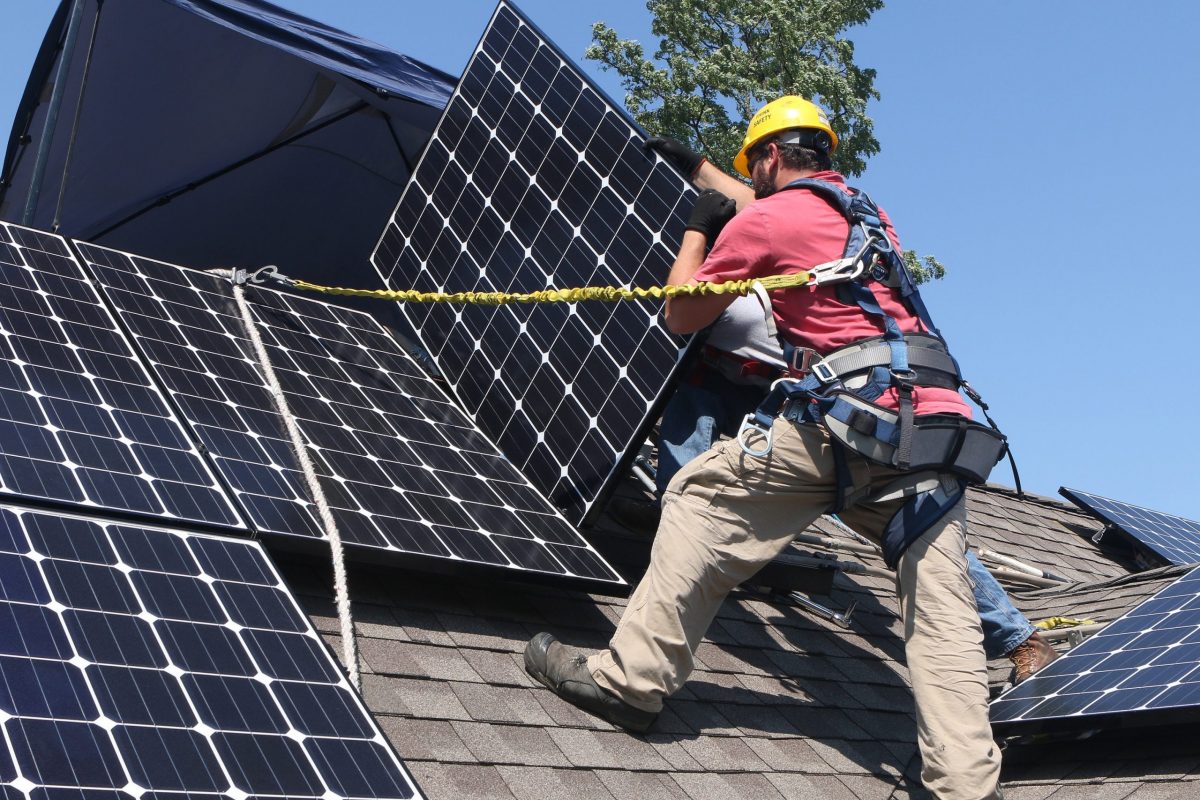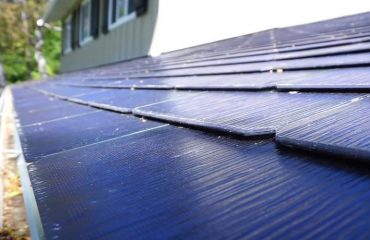Protect your solar investment with a systematic maintenance routine that helps your panels survive extreme weather conditions and maintain peak efficiency. Regular cleaning removes performance-reducing debris, while quarterly inspections catch potential issues before they become costly repairs. Schedule professional check-ups twice yearly to verify electrical connections, mounting hardware, and inverter functionality. Document your maintenance activities, including cleaning dates, energy output readings, and any repairs, to track system performance and optimize your solar investment’s longevity. This comprehensive checklist ensures your solar panels continue delivering maximum energy savings while extending their operational lifespan beyond the standard 25-year warranty period.
Pre-Storm Solar Panel Inspection
Physical Inspection Points
Regular physical inspection of your solar panels helps prevent potential issues and ensures optimal performance. Start by examining the mounting brackets and railings – these should be firmly secured without any signs of rust or loosening. Gently press on different points of the mounting system to check for movement or instability.
Next, inspect the panel surfaces for any physical damage, such as cracks, chips, or discoloration. Pay special attention to the edges and corners where damage typically occurs first. Clean any visible dirt, leaves, or debris that may have accumulated on the panels’ surface.
Check all electrical connections, including the junction boxes and wiring. Look for signs of wear, exposed wires, or loose connections. The wiring should be properly secured and protected from the elements, with no signs of pest damage or deterioration of the protective coating.
Don’t forget to examine the weather sealing around mounting points and electrical connections. Any compromised seals should be addressed promptly to prevent water damage. If you notice any concerning issues during your inspection, it’s best to contact a qualified solar technician for professional assessment and repairs.
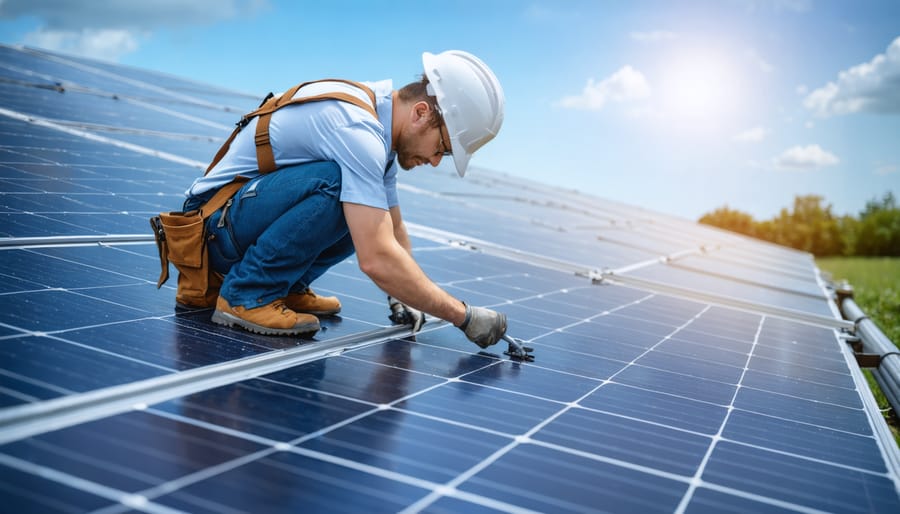
Documentation and Insurance Review
Maintaining detailed records of your solar panel system’s condition is crucial for both warranty purposes and insurance coverage. Create a digital folder or physical file containing your installation documentation, warranty information, and regular maintenance records. Take dated photographs of your panels during each inspection, noting any visible changes or damage.
Review your homeowner’s insurance policy annually to ensure it adequately covers your solar installation against weather-related damage, including hail, wind, and falling debris. Many standard policies include solar panels as part of your home’s structure, but coverage limits may need adjustment to reflect your system’s value.
Keep a maintenance log documenting cleaning dates, performance readings, and any repairs or part replacements. This documentation proves invaluable when filing warranty claims or insurance requests. Include details like weather conditions during maintenance, power output readings, and any professional service visits.
Consider creating a simple spreadsheet to track your system’s performance over time, making it easier to spot trends or potential issues before they become serious problems. Store digital copies of all documentation in cloud storage for easy access and backup.
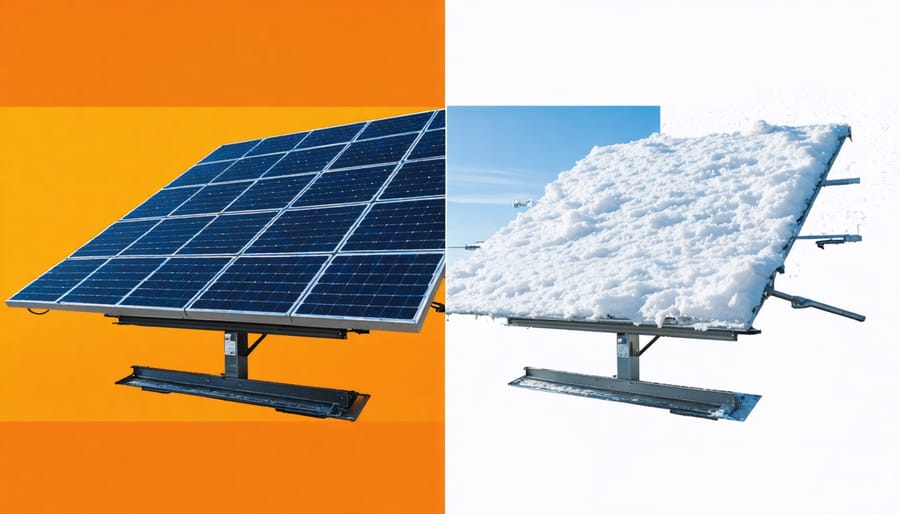
Seasonal Maintenance Tasks
Summer Heat Protection
Summer heat can significantly impact solar panel performance, making proper maintenance crucial during warmer months. Regular cleaning and maintaining solar panels helps prevent efficiency losses and ensures optimal energy production.
Start by inspecting your panels early in the morning or late evening when temperatures are cooler. Remove any dust, pollen, or debris using soft brushes and non-abrasive cleaning solutions. Pay special attention to bird droppings and tree sap, which can create hot spots and reduce panel efficiency.
Check your cooling system components, including inverter fans and ventilation areas. Ensure these are free from obstruction and functioning properly, as they play a vital role in maintaining optimal operating temperatures. Clean or replace air filters if your system includes them.
Consider installing temperature sensors if you haven’t already. These devices alert you when panels exceed optimal temperature ranges, allowing for prompt corrective action. Many modern systems include built-in monitoring capabilities through smartphone apps.
Trim nearby vegetation to improve airflow around your panels and prevent shade from reducing efficiency. If you notice persistent temperature-related performance issues, consider adjusting panel tilt slightly to improve ventilation. Remember to document all maintenance activities and monitor system performance regularly through your inverter’s monitoring system.
For best results, schedule professional inspections before peak summer months to address any potential cooling system concerns proactively.
Winter Weather Preparation
Winter weather can pose unique challenges for solar panel systems, but with proper preparation, you can maintain optimal performance throughout the cold season. The key is to prevent snow accumulation while protecting your system from freeze damage.
For snow removal, invest in a soft-bristled snow rake with an extended handle specifically designed for solar panels. Never use metal tools or regular snow shovels, as these can scratch or damage the panels’ surface. Most solar panels are installed at an angle, allowing snow to naturally slide off as temperatures rise. However, if snow accumulation persists for more than a few days, gentle removal may be necessary.
To protect against freezing, ensure your system’s pipes and components are properly insulated, particularly in areas where temperatures frequently drop below freezing. Consider installing heating strips along water lines and around key components to prevent ice formation. These heating elements can be connected to temperature sensors for automatic activation when conditions warrant.
Monitor your system’s performance during winter months through your monitoring app or device. A sudden drop in energy production might indicate snow coverage or ice formation requiring attention. Remember that light snow coverage often melts quickly and shouldn’t significantly impact your system’s performance.
Keep tree branches trimmed away from panels to prevent snow and ice accumulation from overhanging vegetation. This also reduces the risk of falling branches during winter storms that could damage your solar installation.
Post-Storm Maintenance
Safety First: Initial Assessment
After severe weather, it’s crucial to assess your solar panels safely before conducting any maintenance. Start by checking your system’s monitoring app or device to identify any sudden drops in energy production, which could indicate storm damage. Never attempt to inspect roof-mounted panels during or immediately after adverse weather conditions.
Wait until daylight hours and ensure the weather is clear and stable. From ground level, use binoculars to conduct an initial visual inspection, looking for obvious signs of damage such as loose panels, broken glass, or debris accumulation. Pay special attention to the mounting hardware and any visible wiring.
If you notice any structural damage or electrical issues, do not attempt repairs yourself. Contact your solar installation company or a certified solar maintenance professional immediately. Document any visible damage with photos for insurance purposes.
For ground-mounted systems, maintain a safe distance while inspecting, and never touch panels or wiring if you suspect water damage or exposed electrical components. If your system has an emergency shutdown feature, familiarize yourself with its location and operation before any inspection.
Remember, your safety always comes first – when in doubt, leave the detailed inspection to the professionals.
Damage Documentation
When documenting weather-related damage to your solar panels, start by taking clear, detailed photographs from multiple angles. Capture both close-up shots of specific damage and wider views showing the overall affected area. Note the date and time of the damage, along with weather conditions that may have caused it.
Create a detailed written record describing the type and extent of damage observed. Include specific information such as cracked panels, loose mounting hardware, or debris impact marks. Document any changes in your system’s performance by recording recent energy production data from your monitoring system.
Contact your insurance provider promptly and share your documentation. Many homeowner’s policies cover solar panel damage, but timing is crucial for claims. Keep copies of all correspondence and claim numbers for reference.
If you notice significant damage or performance issues, reach out to your solar installation company for a professional assessment. They can provide an official damage report and repair estimate, which may be required for insurance claims.
Remember to maintain a digital folder with all documentation, including original installation paperwork, warranty information, and maintenance records. This organized approach will streamline the repair and claims process while protecting your investment.
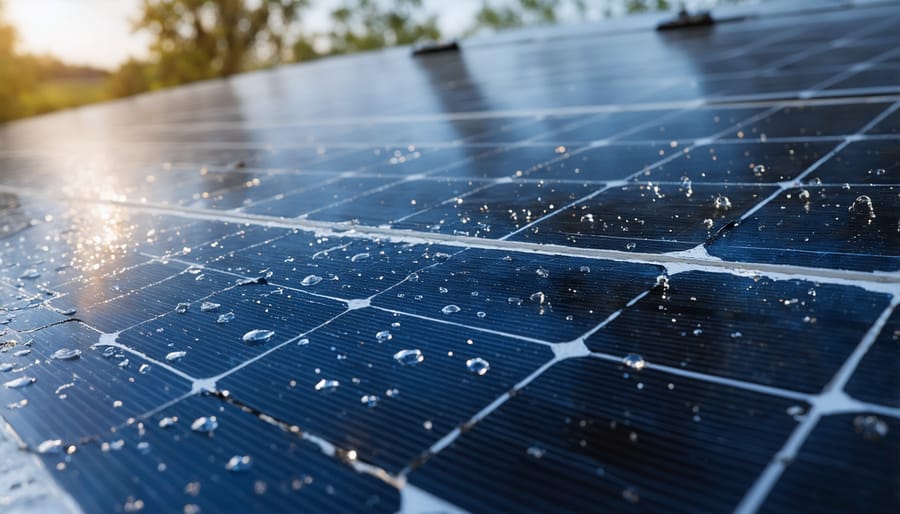
Professional vs DIY Maintenance
While many essential maintenance tasks can be handled by homeowners, it’s crucial to know when to call in the professionals. As a general rule, you can safely perform basic cleaning, visual inspections, and monitoring of your system’s performance through your inverter display or monitoring app.
DIY maintenance typically includes:
– Gentle cleaning with water and a soft brush
– Removing debris like leaves and branches
– Checking for visible damage
– Monitoring energy production
– Keeping nearby trees trimmed
– Recording performance data
However, leave these tasks to certified professionals:
– Electrical connections and wiring repairs
– Roof-mounted panel adjustments
– Inverter repairs or replacements
– Annual professional inspections
– Complex troubleshooting
– Any work requiring climbing onto the roof
For safety reasons, never attempt electrical repairs or maintenance that requires walking on your roof. Professional solar technicians have proper safety equipment, specialized tools, and expertise to handle complex issues. They can also identify potential problems before they become serious, potentially saving you money in the long run.
Remember, your warranty may require professional maintenance, so check your documentation before attempting any repairs yourself. When in doubt, always consult with a certified solar installer or maintenance professional.
Regular maintenance of your solar panels is not just about protecting your investment—it’s about ensuring optimal performance and maximizing your energy savings year after year. By following this maintenance checklist consistently, you’ll keep your panels operating at peak efficiency while extending their lifespan. Remember to conduct visual inspections monthly, clean your panels seasonally, and schedule professional check-ups annually. Stay proactive with your maintenance routine, and don’t wait for problems to arise before taking action. With proper care, your solar panel system will continue to deliver clean, renewable energy and significant cost savings for decades to come. Make this checklist part of your regular home maintenance routine, and you’ll enjoy the full benefits of your solar investment while contributing to a more sustainable future.

